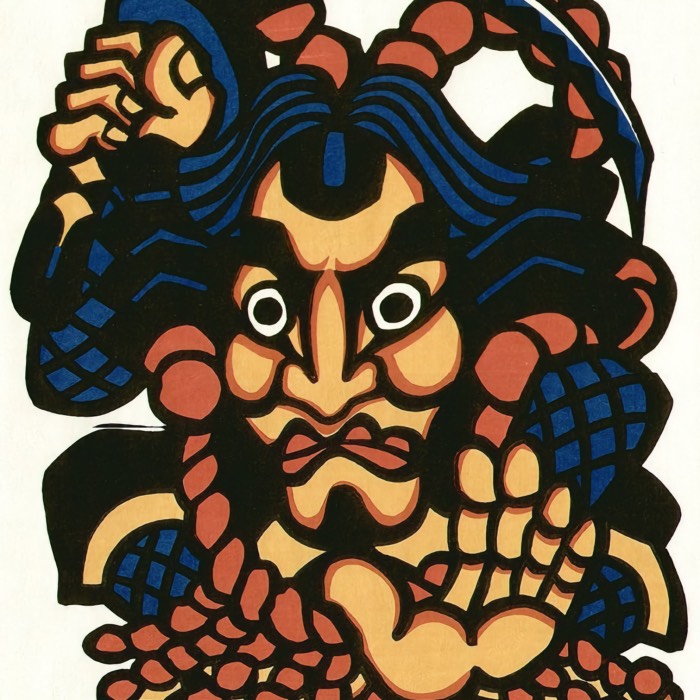Yoshikawa Kampō: Elegant simplicity and refined beauty
Yoshikawa Kampō (1894-1979) was a prominent artist of the Shin Hanga movement, known for his elegant bijin-ga (pictures of beautiful women), yakusha-e (actor prints), and fukeiga (landscapes). He had a deep engagement with traditional Japanese arts, which he skillfully integrated into his work as a woodblock print artist. His prints are celebrated for their refined beauty, graceful compositions, and subtle use of color.
 Kabuki Actor, Yoshikawa Kampō, 1920. Source: ukiyo-e.orgꜛ
Kabuki Actor, Yoshikawa Kampō, 1920. Source: ukiyo-e.orgꜛ
Biography
Yoshikawa Kampō (吉川 観方), born Yoshikawa Yoshio on August 28, 1894, in Kyoto, Japan, was an influential artist and scholar who played a significant role in the Shin Hanga movement. Kampō is particularly known for his refined bijin-ga (pictures of beautiful women) and yakusha-e (actor prints) and his deep engagement with the traditional arts of Japan, which he skillfully integrated into his work as a woodblock print artist.
Kampō was born into a family with a strong artistic heritage. His father was a painter, and Kampō was exposed to the arts from a young age. He was particularly drawn to Nihonga (traditional Japanese painting), a style that would heavily influence his later work. He studied at the Kyoto Municipal School of Arts and Crafts, where he received formal training in traditional Japanese painting techniques. This education provided Kampō with a solid foundation in the aesthetics and principles of classical Japanese art, which he would later incorporate into his woodblock prints.
In addition to his work as an artist, Kampō was also a respected scholar and collector of Japanese art. He had a deep interest in the history and techniques of traditional Japanese crafts, particularly in the area of textile design, and he published several books on these subjects. His scholarly work informed his artistic practice, allowing him to create prints that were both technically accomplished and rich in cultural significance.
Kampō became associated with the Shin Hanga movement in the early 20th century, contributing to its revival of traditional Japanese woodblock printing. His work was well-received both in Japan and abroad, particularly for its elegant compositions and subtle use of color.
Yoshikawa Kampō passed away on April 5, 1979, leaving behind a legacy as a master of refined and elegant bijin-ga, as well as a significant figure in the preservation and promotion of traditional Japanese arts.
Artistic style and significance
Yoshikawa Kampō is best known for his bijin-ga, yakusha-e, and fukeiga prints, which are celebrated for their elegant simplicity, refined beauty, and deep connection to traditional Japanese aesthetics. His work reflects a profound respect for Japan’s artistic heritage while also embracing the modern sensibilities that characterized the Shin Hanga movement.
Bijin-ga: The art of graceful beauty
Kampō’s bijin-ga prints are noted for their portrayal of women with a sense of grace and poise. His subjects are often depicted in traditional Japanese attire, engaged in moments of quiet reflection or simple activities. Kampō’s approach to bijin-ga is characterized by a minimalist aesthetic, with a focus on the purity of line and form. His women are rendered with delicate, flowing lines and a restrained use of color, creating a sense of harmony and balance in each composition.
Unlike some of his contemporaries who experimented with more modern or Westernized styles, Kampō remained deeply committed to traditional Japanese ideals of beauty. His bijin-ga often reflect the values of modesty, elegance, and refinement that were central to Japanese culture. This focus on traditional aesthetics, combined with his technical skill, allowed Kampō to create prints that are timeless in their appeal.
Yakusha-e and Fukeiga
In addition to his bijin-ga, Yoshikawa Kampō also produced yakusha-e (actor prints) and fukeiga (landscapes). His yakusha-e are characterized by their detailed depictions of actors in traditional kabuki roles, capturing the drama and intensity of the performances. Kampō’s fukeiga, on the other hand, showcase his skill in rendering landscapes with a sense of serenity and tranquility. These prints often feature scenes of natural beauty, imbued with a sense of quiet contemplation.
 Fair Weather After Snow at Yamato Bridge, Kyoto (Yamato bashi no yukibare), Yoshikawa Kampō, 1924. Source: ukiyo-e.orgꜛ
Fair Weather After Snow at Yamato Bridge, Kyoto (Yamato bashi no yukibare), Yoshikawa Kampō, 1924. Source: ukiyo-e.orgꜛ
Influence of Nihonga and textile design
Kampō’s training in Nihonga had a significant impact on his work as a woodblock print artist. His prints often feature the soft, muted colors and subtle gradations of tone that are characteristic of Nihonga. This influence is particularly evident in his use of color to convey mood and atmosphere, as well as in his attention to the delicate details of his subjects’ clothing and accessories.
Kampō’s interest in textile design is also reflected in his work. His prints often showcase the intricate patterns and textures of traditional Japanese fabrics, rendered with a level of detail and precision that demonstrates his deep knowledge of textile arts. This attention to detail not only enhances the visual appeal of his prints but also adds a layer of cultural significance, connecting his work to the broader traditions of Japanese craftsmanship.
Legacy and impact
Yoshikawa Kampō’s contribution to the Shin Hanga movement is significant, particularly in the genre of bijin-ga. His work helped to preserve and promote traditional Japanese aesthetics during a time of rapid modernization, and his prints continue to be celebrated for their elegance and refinement. Kampō’s ability to blend traditional techniques with a modern sensibility made his work relevant to both Japanese and Western audiences, and his prints remain highly valued by collectors today.
Kampō’s legacy also extends beyond his work as an artist. His scholarly contributions to the study of Japanese textiles and crafts have had a lasting impact on the preservation and appreciation of traditional Japanese arts. Through his art and scholarship, Kampō played a crucial role in ensuring that these cultural traditions would be passed down to future generations.
Notable works
Throughout his career, Yoshikawa Kampō produced several notable prints that are considered masterpieces of the Shin Hanga movement. Here are some of his most famous works:
 Sanjo Ohashi (variant), Yoshikawa Kampō. Source: ukiyo-e.orgꜛ
Sanjo Ohashi (variant), Yoshikawa Kampō. Source: ukiyo-e.orgꜛ


Left: Actor Kataoka Gado as Miyuki, Yoshikawa Kampō. Source: ukiyo-e.orgꜛ – Right: Maiko Admiring the Moon, Yoshikawa Kampō, 1924. Source: ukiyo-e.orgꜛ


Left: Kamiya Jihei, Yoshikawa Kampō, 1923. Source: ukiyo-e.orgꜛ – Right: Young Dancer Hinazo, Yoshikawa Kampō, 1922. Source: ukiyo-e.orgꜛ
 Going through the Snowy Woods, Yoshikawa Kampō, 1910-1920s. Source: ukiyo-e.orgꜛ
Going through the Snowy Woods, Yoshikawa Kampō, 1910-1920s. Source: ukiyo-e.orgꜛ

Minokawa Enjaku as Igami-no-gonta in the play ‘Yoshitsune Senbonzakura’, Yoshikawa Kampō, 1923. Source: ukiyo-e.orgꜛ


Left: Actor, Ichikawa Sadanji. Source: ukiyo-e.orgꜛ – Right: Ichikawa Sadanji, Yoshikawa Kampō, 1923. Source: ukiyo-e.orgꜛ
 Cherry Blossoms at Night, Maruyama Park, Yoshikawa Kampō, 1925. Source: ukiyo-e.orgꜛ
Cherry Blossoms at Night, Maruyama Park, Yoshikawa Kampō, 1925. Source: ukiyo-e.orgꜛ
Conclusion
Yoshikawa Kampō is remembered as one of the most significant artists of the Shin Hanga movement, particularly for his contributions to the genres of bijin-ga, yakusha-e, and fukeiga. His prints, characterized by their elegant simplicity, refined beauty, and deep connection to traditional Japanese aesthetics, continue to be celebrated for their craftsmanship and cultural significance. Kampō’s work remains highly valued by collectors and art enthusiasts, ensuring his lasting place in the history of Japanese art.
References and further reading
- Chris Uhlenbeck, Jim Dwinger, Philo Ouweleen, Shin Hanga - Die »Neuen Drucke« Japans 1900-1950, 2022, Hatje Cantz, ISBN: 9783775752190
- viewingjapaneseprints.netꜛ
- Yoshiwara Kampō on ukyio-e.orgꜛ










comments